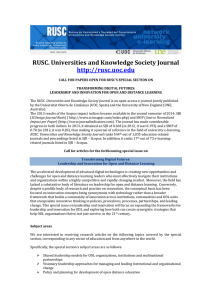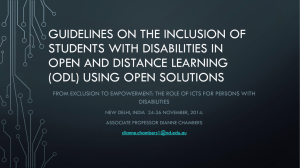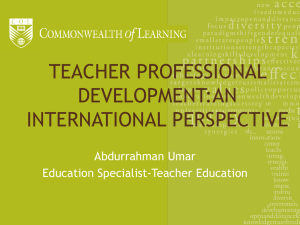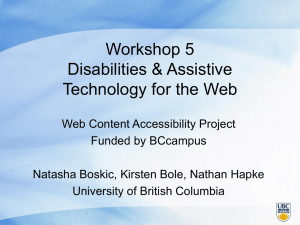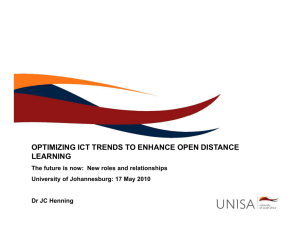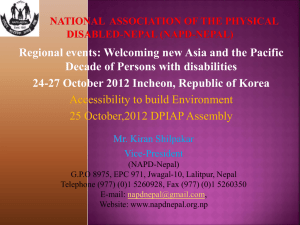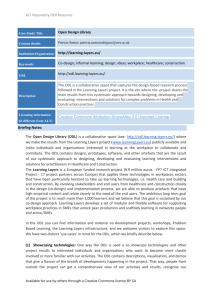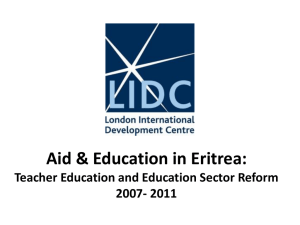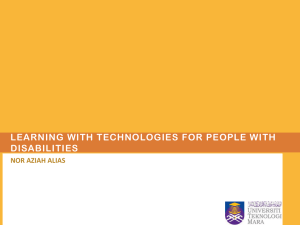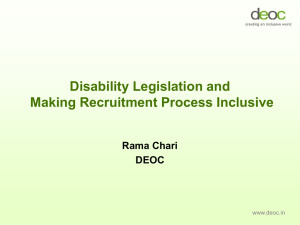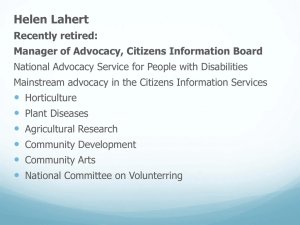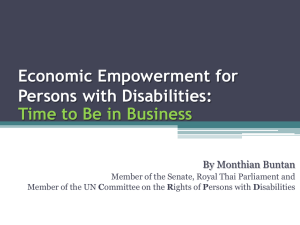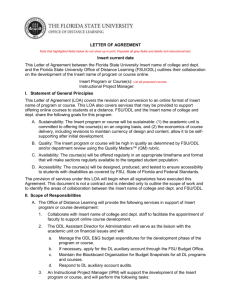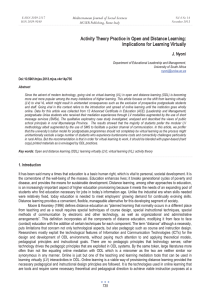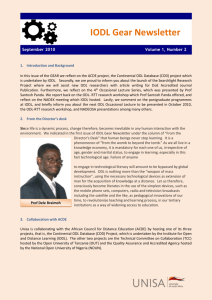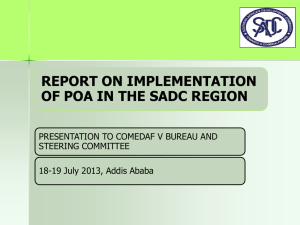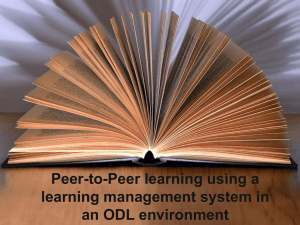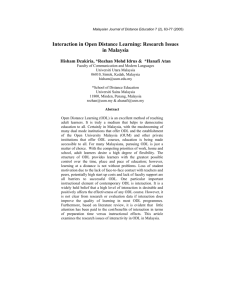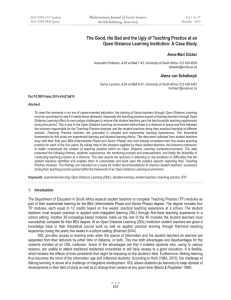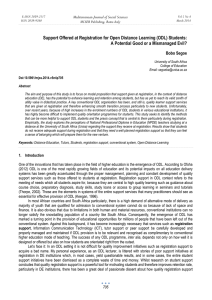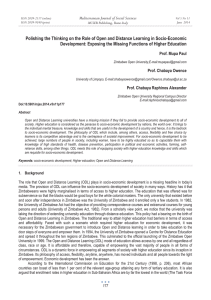sudesh_mukhopadhyay_session_2
advertisement
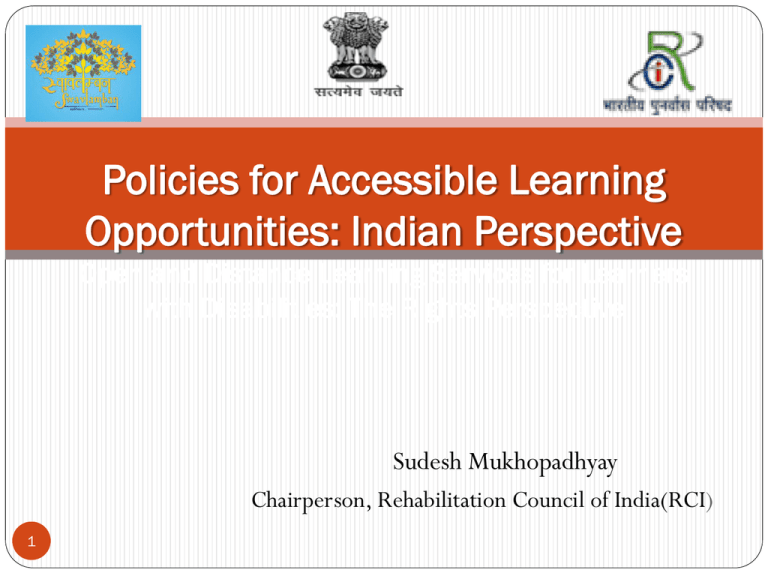
Policies for Accessible Learning Opportunities: Indian Perspective Open and Distance Learning Services for Learners with Disabilities: The Rights Perspective Sudesh Mukhopadhyay Chairperson, Rehabilitation Council of India(RCI) 1 The Information Age 2 Unprecedented opportunities for persons with disabilities to participate in society Access to knowledge, information and services Possibility of ensuring equal opportunities for all Inclusion and participation in society Involvement in social, cultural, business and administrative processes Accessibility Policies : Key Features Coverage – types of accessibility included e.g. web, electronic, other Scope - legislation vs. policy WCAG compliance Applicability – public sector only or private sector as well Mechanisms for review, monitoring and compliance 3 Barriers 4 Inaccessible and unaffordable technologies Inaccessible web sites Unsupportive laws Lack of awareness Lack of accountability on the internet Accessibility Policies : India Generic legislation – Persons with Disabilities (Equal Opportunities, 5 Protection of Rights & Full Participation) Act 1995 No accessibility specific legislation or policy yet Review of PwD Act 1995 in progress; government working with NGOs and disability rights groups to frame policy , get it enacted Copyright Amendment Bill 2012 opens many avenues with significant implications for accessible materials in alternative formats Signatory to both UNCRPD (2006) and Biwako Millennium framework towards an Inclusive, Barrier-free and Rights-based Society for PWDs in Asia and the Pacific (2002) In absence of domestic law on accessibility, international conventions and norms are considered ensuring that they do not contradict enacted domestic law Accessible Learning Environment Physical: Access to buildings, classrooms, public utilities, technologies(Adapted hardware) Curriculum: Access to Courses, materials , pedagogy-Responsive & Inclusive, teaching aids and learning tools, delivery modes- contact situations, distance learning and e-learning Social: Access to peer learning situations, sharing sites, interaction opportunities 6 Programmes and Schemes: Exemplars School Education: Sarva Shiksha Abhiyan (SSA),Inclusive Education for Disabled at Secondary Stage(IEDSS) Higher Education: Higher Education for Persons with Special Needs(HEPSEN), Teacher Preparation in Special Education (TEPSE) , Enabling Units, Equal opportunity offices Besides all other Components of accessible Environment ICT Usage and applications is the Focus ICT Policy of GOI also addresses but in a generic way Assistance to Disabled persons Scheme(ADIP) 7 Status: School Education-1 Computer aided instruction in general still not a norm, some exposure though many companies like IBM working with governments. Limited exposure of Students with Disabilities. Personal Computers and devices being promoted under special assistance programmes Flexible and responsive school -end examinations Special schools of good standing more inclined towards using ICT for Children and Young Persons with Cerebral Palsy, Intellectual Disabilities (MR, LD), Autism, Visual and Hearing Impairment, Multiple Disabilities 8 Status: School Education-2 National Institute of Open Schooling(NIOS) and State Open 9 Schools do use distance education mode with accredited institutes/schools as contact point through regional centres. Use Print Media, mostly Braille OER a choice available; e.g. NCERT books available as OER Accessibility through use of computers and flexible examination policies National Institute for Visually Handicapped and few others transcript in Audio and Braille Textbooks and other reading materials Status: School Education-3 Some NGOs also prepare Augmentative and Alternate Materials such as Low Tech Communication Charts for ID,Vi,ASD and CP – Pictures/words/Tactile by Vidya Sagar, Many a times Appex Institutes like IITs join Hands, SANYOG Communication Software by IIT Kharagpur & Lab Asia Adapted Computers(Aditi,Hardware,CP), Indian Picture Symbol for Communication, GupShup Software(by IICP) 10 Status: Higher Education Not enough students reaching higher education Enabling units and Equal opportunity offices facilitate More young persons with Locomotor Disabilities Issue of Course Options and accessible infrastructure 11 Challenges for ODL for PwDs-1 Agencies of ODL within the Government and Private Service Providers DEB/ DEC lists more of Central and State universities approved for ODL, few private universities No dedicated University for Rehabilitation and /or with focus on Disability related issues School level ODL strategies not very clear & organized 12 Challenges for ODL for PwDs-2 ODL’s basic characteristics very suitable for PwDs; but design, accountability and monitoring systems a great challenge Course materials not adapted for different disabilities Challenge of procuring assistive devices to use ICT to the maximum advantage New Copyright amendment of 2012 likely to improve situation 13 Challenges for ODL for PwDs-3 Instructional design will need indulgence of subject experts, pedagogy experts and ematerial designers Literal translation/transformation not a great answer Intellectual disabilities ignored for secondary and higher education while ODL can be more responsive 14 Looking into Future In an age of Creative destruction- Evolving Opportunities to Obsolete technologies, the scenario for skilling, re-skilling and upskilling needs to be built up for all levels of learning Learning Environments for all but specially for PwDs need to target for relevance, employability and value creation 15 ODL related Challenges-1 Commonly referred platforms such as Windows, MAC, paper-based Training of PWDs to use these in an era where these undergo rapid change The Issue of language used- Written, Audio and Sign coupled with those users who need communication Boards-pictorial All these can be barrier for accessibility 16 ODL related Challenges-2 Content Specification, Selection, Sequence Linear, multiple and fast track routing: Audio tapes, Digital Accessible Information System (DAISY), abridged , nature and number of frames, dealing with instructional design as well as assistive technology and technology applications Screen readers and or audio material do not address individual challenge of every Blind or Low vision student or even LD,ID and many other conditions Captions for Fugues and Pictures are equally important for Hearing Impaired as well as other Learners(With or without disabilities) 17 ODL related Challenges-3 Colours and multiple examples from unfamiliar contexts can equally confuse Low Vision learners as well as sighted, especially Intellectually Challenged, Autistic Learner Universal design a good concept but specific needs also needs to be considered In Indian context Software professionals need to work with Special educators and also Specialists of Assistive Devices Availability & Affordability the biggest challenge in Indian Context 18
